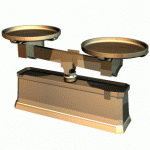
The official standard for the kilogram is a cylinder of platinum and iridium made in 1879 and kept in a vault in France. Scientists have made official copies and distributed them since that time, but many of those copies don’t equal each other in mass, and the original is undergoing decay. So now researchers are trying to come up with a new definition of the kilogram:
It’s a conundrum scientists need to solve because the kilogram is one of a few base units (like the second and the meter) that are used in the definitions of other, more complex units, such as those used to measure temperature, electricity or density. If the kilogram is off, even a little, critical measurements in science, engineering and commerce get messed up.[...]
The U.S. National Institute of Standards and Technology is backing a definition based on the Planck Constant, a number from quantum mechanics. It’s a more complex definition than a simple cylinder, but it’s unlikely to change over the next century.
 The official standard for the kilogram is a cylinder of platinum and iridium made in 1879 and kept in a vault in France. Scientists have made official copies and distributed them since that time, but many of those copies don’t equal each other in mass, and the original is undergoing decay. So now researchers are trying to come up with a new definition of the kilogram:
The official standard for the kilogram is a cylinder of platinum and iridium made in 1879 and kept in a vault in France. Scientists have made official copies and distributed them since that time, but many of those copies don’t equal each other in mass, and the original is undergoing decay. So now researchers are trying to come up with a new definition of the kilogram:
No comments:
Post a Comment